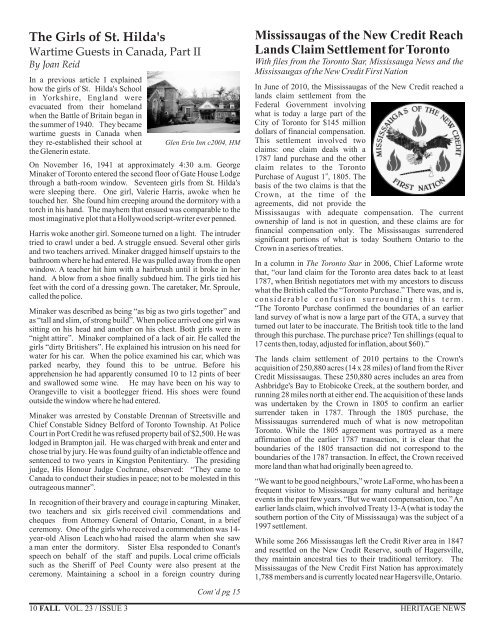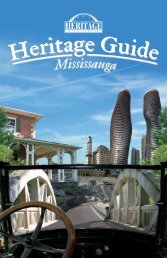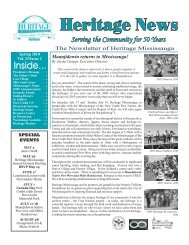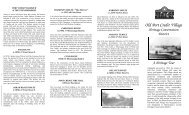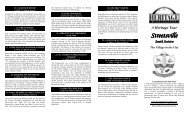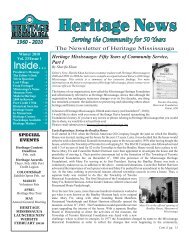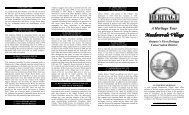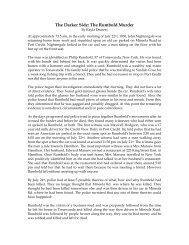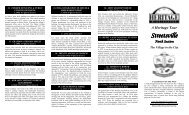Fall 2010 - Heritage Mississauga
Fall 2010 - Heritage Mississauga
Fall 2010 - Heritage Mississauga
You also want an ePaper? Increase the reach of your titles
YUMPU automatically turns print PDFs into web optimized ePapers that Google loves.
The Girls of St. Hilda's<br />
Wartime Guests in Canada, Part II<br />
By Joan Reid<br />
In a previous article I explained<br />
how the girls of St. Hilda's School<br />
in Yorkshire, England were<br />
evacuated from their homeland<br />
when the Battle of Britain began in<br />
the summer of 1940. They became<br />
wartime guests in Canada when<br />
they re-established their school at<br />
the Glenerin estate.<br />
Glen Erin Inn c2004, HM<br />
On November 16, 1941 at approximately 4:30 a.m. George<br />
Minaker of Toronto entered the second floor of Gate House Lodge<br />
through a bath-room window. Seventeen girls from St. Hilda's<br />
were sleeping there. One girl, Valerie Harris, awoke when he<br />
touched her. She found him creeping around the dormitory with a<br />
torch in his hand. The mayhem that ensued was comparable to the<br />
most imaginative plot that a Hollywood script-writer ever penned.<br />
Harris woke another girl. Someone turned on a light. The intruder<br />
tried to crawl under a bed. A struggle ensued. Several other girls<br />
and two teachers arrived. Minaker dragged himself upstairs to the<br />
bathroom where he had entered. He was pulled away from the open<br />
window. A teacher hit him with a hairbrush until it broke in her<br />
hand. A blow from a shoe finally subdued him. The girls tied his<br />
feet with the cord of a dressing gown. The caretaker, Mr. Sproule,<br />
called the police.<br />
Minaker was described as being “as big as two girls together” and<br />
as “tall and slim, of strong build”. When police arrived one girl was<br />
sitting on his head and another on his chest. Both girls were in<br />
“night attire”. Minaker complained of a lack of air. He called the<br />
girls “dirty Britishers”. He explained his intrusion on his need for<br />
water for his car. When the police examined his car, which was<br />
parked nearby, they found this to be untrue. Before his<br />
apprehension he had apparently consumed 10 to 12 pints of beer<br />
and swallowed some wine. He may have been on his way to<br />
Orangeville to visit a bootlegger friend. His shoes were found<br />
outside the window where he had entered.<br />
Minaker was arrested by Constable Drennan of Streetsville and<br />
Chief Constable Sidney Belford of Toronto Township. At Police<br />
Court in Port Credit he was refused property bail of $2,500. He was<br />
lodged in Brampton jail. He was charged with break and enter and<br />
chose trial by jury. He was found guilty of an indictable offence and<br />
sentenced to two years in Kingston Penitentiary. The presiding<br />
judge, His Honour Judge Cochrane, observed: “They came to<br />
Canada to conduct their studies in peace; not to be molested in this<br />
outrageous manner”.<br />
In recognition of their bravery and courage in capturing Minaker,<br />
two teachers and six girls received civil commendations and<br />
cheques from Attorney General of Ontario, Conant, in a brief<br />
ceremony. One of the girls who received a commendation was 14-<br />
year-old Alison Leach who had raised the alarm when she saw<br />
a man enter the dormitory. Sister Elsa responded to Conant's<br />
speech on behalf of the staff and pupils. Local crime officials<br />
such as the Sheriff of Peel County were also present at the<br />
ceremony. Maintaining a school in a foreign country during<br />
Cont’d pg 15<br />
<strong>Mississauga</strong>s of the New Credit Reach<br />
Lands Claim Settlement for Toronto<br />
With files from the Toronto Star, <strong>Mississauga</strong> News and the<br />
<strong>Mississauga</strong>s of the New Credit First Nation<br />
In June of <strong>2010</strong>, the <strong>Mississauga</strong>s of the New Credit reached a<br />
lands claim settlement from the<br />
Federal Government involving<br />
what is today a large part of the<br />
City of Toronto for $145 million<br />
dollars of financial compensation.<br />
This settlement involved two<br />
claims: one claim deals with a<br />
1787 land purchase and the other<br />
claim relates to the Toronto<br />
st<br />
Purchase of August 1 , 1805. The<br />
basis of the two claims is that the<br />
Crown, at the time of the<br />
agreements, did not provide the<br />
<strong>Mississauga</strong>s with adequate compensation. The current<br />
ownership of land is not in question, and these claims are for<br />
financial compensation only. The <strong>Mississauga</strong>s surrendered<br />
significant portions of what is today Southern Ontario to the<br />
Crown in a series of treaties.<br />
In a column in The Toronto Star in 2006, Chief Laforme wrote<br />
that, “our land claim for the Toronto area dates back to at least<br />
1787, when British negotiators met with my ancestors to discuss<br />
what the British called the “Toronto Purchase.” There was, and is,<br />
considerable confusion surrounding this term.<br />
“The Toronto Purchase confirmed the boundaries of an earlier<br />
land survey of what is now a large part of the GTA, a survey that<br />
turned out later to be inaccurate. The British took title to the land<br />
through this purchase. The purchase price? Ten shillings (equal to<br />
17 cents then, today, adjusted for inflation, about $60).”<br />
The lands claim settlement of <strong>2010</strong> pertains to the Crown's<br />
acquisition of 250,880 acres (14 x 28 miles) of land from the River<br />
Credit <strong>Mississauga</strong>s. These 250,880 acres includes an area from<br />
Ashbridge's Bay to Etobicoke Creek, at the southern border, and<br />
running 28 miles north at either end. The acquisition of these lands<br />
was undertaken by the Crown in 1805 to confirm an earlier<br />
surrender taken in 1787. Through the 1805 purchase, the<br />
<strong>Mississauga</strong>s surrendered much of what is now metropolitan<br />
Toronto. While the 1805 agreement was portrayed as a mere<br />
affirmation of the earlier 1787 transaction, it is clear that the<br />
boundaries of the 1805 transaction did not correspond to the<br />
boundaries of the 1787 transaction. In effect, the Crown received<br />
more land than what had originally been agreed to.<br />
“We want to be good neighbours,” wrote LaForme, who has been a<br />
frequent visitor to <strong>Mississauga</strong> for many cultural and heritage<br />
events in the past few years. “But we want compensation, too.” An<br />
earlier lands claim, which involved Treaty 13-A (what is today the<br />
southern portion of the City of <strong>Mississauga</strong>) was the subject of a<br />
1997 settlement.<br />
While some 266 <strong>Mississauga</strong>s left the Credit River area in 1847<br />
and resettled on the New Credit Reserve, south of Hagersville,<br />
they maintain ancestral ties to their traditional territory. The<br />
<strong>Mississauga</strong>s of the New Credit First Nation has approximately<br />
1,788 members and is currently located near Hagersville, Ontario.<br />
10 FALL VOL. 23 / ISSUE 3<br />
HERITAGE NEWS


